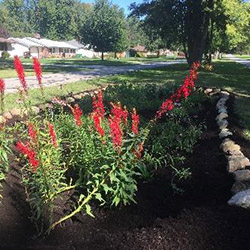 Does your yard experience continuous standing water through the springtime? Northeast Ohio has seen increased spring precipitation over the past few years which can lead to stormwater challenges on residential properties. Stormwater is any rainwater, melting snow or ice that flows over the surface of the land to the nearest storm sewer, lake, or stream.
Does your yard experience continuous standing water through the springtime? Northeast Ohio has seen increased spring precipitation over the past few years which can lead to stormwater challenges on residential properties. Stormwater is any rainwater, melting snow or ice that flows over the surface of the land to the nearest storm sewer, lake, or stream.
Hard surfaces like driveways, roofs, and parking lots contribute to a couple major stormwater problems: (1) pollution like litter, debris, or oils, which stormwater carries to its destination untreated, and (2) increased flow, where the water flows quickly and in larger volumes, causing increased flooding and erosion. Stormwater runoff contributes to regional stream flooding, erosion, and water-quality issues, and can create costly problems for communities and residents.
Unlike water from toilets, showers, and sinks which is filtered through a wastewater treatment facility, anything that enters a storm sewer system or roadside ditches goes directly into local streams and eventually Lake Erie. There are multiple stormwater control measures that are available to install on your property that will help solve water problems.
Rain Gardens: These are landscaped, depressed gardens filled with native, water and drought tolerant plants that help infiltrate stormwater. Rain gardens are designed to capture runoff from rooftops, driveways, or lawns and allow water to temporarily pool within the garden. Rain gardens naturally manage stormwater by infiltrating precipitation and allowing it to soak into the ground rather than sending it directly to storm sewers and nearby streams untreated. Rain gardens also provide great habitat for pollinators like bees and butterflies. Sign up at crwp.org today to become a Master Rain Gardener and learn how to design and install your own rain garden!
Permeable Pavement: With the continuous development of our cities, we are increasing the amount of impervious cover of the land and reducing green space. This means there is less space for stormwater to soak into the ground when there are heavy rain events, leading to flooding and other issues. Permeable pavement is a porous surface that catches rain, snow, and stormwater and stores it in an underlying stone reservoir while slowly releasing it into the ground.
Rain Barrels: These barrels can typically hold up to 55 gallons of stormwater and are very easy to install! Once fitted to your house’s downspout, the barrel can collect stormwater and reduce your need for municipal water. Instead of water running off your roof and pooling onto your lawn, it sits in the rain barrel where it can be used for other purposes such as watering plants or your lawn during hot or dry spells!
Plant a Tree: This is a simple solution to any stormwater issue. Trees naturally absorb lots of water, so planting one in an area that receives an excess of stormwater could help reduce ponding in your yard. A medium-sized tree can capture as much as 2,300 gallons of rainfall every year! Tree roots also promote infiltration of stormwater into the soil, leading to less water ponding on your lawn and less flooding and erosion downstream.
If everyone installed at least one stormwater control measure on their property, we could help keep water clean by filtering stormwater runoff before it enters streams and ultimately Lake Erie! It is important to check with your local ordinances before installing a stormwater control measure on your property.
For more information on these stormwater control measures and advice on how to implement them, visit crwp.org.
